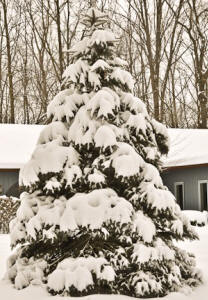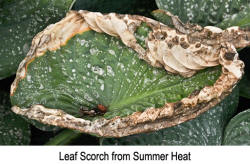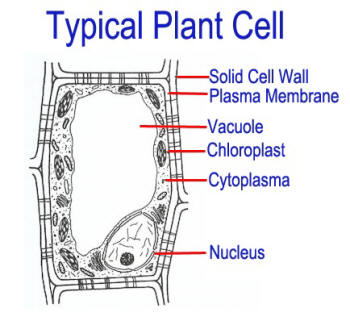When many gardeners hear the term "hardiness"
they think of cold weather. Cold hardiness is a major
factor that helps determine the survival of plants in
our beds and borders in
temperate regions. The United
States Department of Agriculture (USDA) has developed a
map that shows different zones based on their typical
minimum winter temperatures.

Cold hardiness zones are most closely relevant to woody
plants. The temperatures cited are air temperatures that
are experienced by exposed woody trunks and stems.
Through various "hardening" techniques, these plant
tissues have become adapted to surviving in cold
environments.
Plants such as
herbaceous perennials and
bulbs have
adapted to cold winters by having their above ground
tissues die down to the ground each autumn. They survive
underground because of the insulating quality of the
soil. A few inches beneath the soil surface,
temperatures rarely go below the twenty to thirty degree
range even if the air temperatures drop to subzero
readings. If there is a covering of snow, the
temperatures are even further moderated for the crowns,
roots and bulbs in the ground.
More and more attention is being given to other types of
plant hardiness. In some regions of the world, the key
challenge for plants is to survive extremely hot, dry
summers. Exposure to winter winds which will dry out
exposed plant tissue may also be a challenge regardless
of the minimum air temperature. Other areas experience
basically two season per year, one wet and one dry.
Plant catalogs, labels and references in books or on the
internet will provide you with the hardiness zone
information for nearly all ornamental plants available
today. Generally, these will be based on long-term
observations of the plants in the landscape while a few
may be based on scientific research at universities.
Occasionally, newly introduced plants will be rated
based on the climate at their native land which may or
may not relate to your home's environment.
Remember that, regardless of its source, these ratings
are generalizations. Your specific landscape site might
have certain "microclimates" which may actually be
milder or harsher that your USDA Zone would indicate.
 For instance, if your property has a
hill which slopes down into a very low lying area, this
may have an impact on the hardiness of your plants. Cold
air will settle down into the low area which may then
experience temperatures several degrees cooler than at
the top of the hill. This is especially important in the
early spring when a frost may wipe out flower buds and
new growth on plants down low and not bother those at
the top of the hill.
For instance, if your property has a
hill which slopes down into a very low lying area, this
may have an impact on the hardiness of your plants. Cold
air will settle down into the low area which may then
experience temperatures several degrees cooler than at
the top of the hill. This is especially important in the
early spring when a frost may wipe out flower buds and
new growth on plants down low and not bother those at
the top of the hill.
Also, the direction and intensity of winds on your
property may cause a discrepancy in hardiness levels.
Some plants such as
rhododendrons may be hardy for cold
temperatures in your region but may be severely damaged
by being exposed to high velocity winter winds. These
will dry out the foliage and the frozen ground will not
allow the plant to replenish them until it thaws.

Finally, a plant's hardiness level is often related to
its general health and vigor as it enters the difficult
weather period. Plants stressed by drought, poor
nutrition or improper growing conditions may be less
able to survive weather stresses. They may be generally
hardy for your USDA Zone but, if they are not in good
shape coming out of the summer, they may suffer winter
damage anyway.
A note on the effects of global
warming: Traditionally, the concept of cold hardiness is
based on a one time exposure to low temperatures. Just
because the average temperature for an area may be on
the rise does not automatically mean that the cold
hardiness rating will change.
The average temperature may go up a few degrees and that
will affect other aspects of the growing and blooming
season of a plant. However, if just one night in the
winter drops below the cold hardiness rating for a
plant, it may still die. If the plant thrives for 364
days but is subjected to temperatures that cause its
cells to freeze and to burst their solid cell walls on
the other night…it is still dead.



